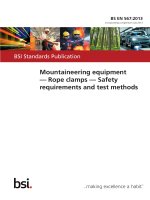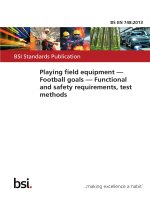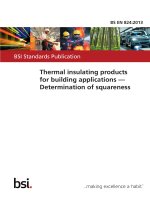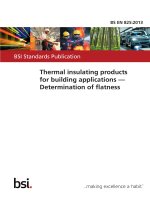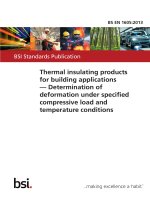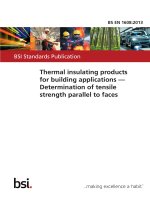Bsi bs en 62068 2013
Bạn đang xem bản rút gọn của tài liệu. Xem và tải ngay bản đầy đủ của tài liệu tại đây (1.1 MB, 20 trang )
BS EN 62068:2013
BSI Standards Publication
Electrical insulating materials
and systems — General
method of evaluation of
electrical endurance under
repetitive voltage impulses
BRITISH STANDARD
BS EN 62068:2013
National foreword
This British Standard is the UK implementation of EN 62068:2013. It
is identical to IEC 62068:2013. It supersedes BS EN 62068-1:2003
which is withdrawn.
The UK participation in its preparation was entrusted to Technical
Committee GEL/112, Evaluation and qualification of electrical insulating
materials and systems.
A list of organizations represented on this committee can be obtained on
request to its secretary.
This publication does not purport to include all the necessary provisions of
a contract. Users are responsible for its correct application.
© The British Standards Institution 2013.
Published by BSI Standards Limited 2013
ISBN 978 0 580 77740 0
ICS 29.080.30
Compliance with a British Standard cannot confer immunity from
legal obligations.
This British Standard was published under the authority of the
Standards Policy and Strategy Committee on 31 October 2013.
Amendments/corrigenda issued since publication
Date
Text affected
BS EN 62068:2013
EUROPEAN STANDARD
EN 62068
NORME EUROPÉENNE
September 2013
EUROPÄISCHE NORM
ICS 29.080.30
Supersedes EN 62068-1:2003
English version
Electrical insulating materials and systems General method of evaluation of electrical endurance under repetitive
voltage impulses
(IEC 62068:2013)
Matériaux et systèmes d'isolation
électriques Méthode générale d'évaluation de
l'endurance électrique soumise à des
impulsions de tension appliquées
périodiquement
(CEI 62068:2013)
Elektrische Isolierstoffe und
Isoliersysteme Allgemeines Verfahren zur Bewertung der
elektrischen Lebensdauer bei
Beanspruchung mit sich wiederholenden
Spannungsimpulsen
(IEC 62068:2013)
This European Standard was approved by CENELEC on 2013-04-15. CENELEC members are bound to comply
with the CEN/CENELEC Internal Regulations which stipulate the conditions for giving this European Standard
the status of a national standard without any alteration.
Up-to-date lists and bibliographical references concerning such national standards may be obtained on
application to the CEN-CENELEC Management Centre or to any CENELEC member.
This European Standard exists in three official versions (English, French, German). A version in any other
language made by translation under the responsibility of a CENELEC member into its own language and notified
to the CEN-CENELEC Management Centre has the same status as the official versions.
CENELEC members are the national electrotechnical committees of Austria, Belgium, Bulgaria, Croatia, Cyprus,
the Czech Republic, Denmark, Estonia, Finland, Former Yugoslav Republic of Macedonia, France, Germany,
Greece, Hungary, Iceland, Ireland, Italy, Latvia, Lithuania, Luxembourg, Malta, the Netherlands, Norway, Poland,
Portugal, Romania, Slovakia, Slovenia, Spain, Sweden, Switzerland, Turkey and the United Kingdom.
CENELEC
European Committee for Electrotechnical Standardization
Comité Européen de Normalisation Electrotechnique
Europäisches Komitee für Elektrotechnische Normung
CEN-CENELEC Management Centre: Avenue Marnix 17, B - 1000 Brussels
© 2013 CENELEC -
All rights of exploitation in any form and by any means reserved worldwide for CENELEC members.
Ref. No. EN 62068:2013 E
BS EN 62068:2013
EN 62068:2013
-2-
Foreword
The text of document 112/234/FDIS, future edition 1 of IEC 62068, prepared by IEC TC 112 "Evaluation
and qualification of electrical insulating materials and systems" was submitted to the IEC-CENELEC
parallel vote and approved by CENELEC as EN 62068:2013.
The following dates are fixed:
•
•
latest date by which the document has
to be implemented at national level by
publication of an identical national
standard or by endorsement
latest date by which the national
standards conflicting with the
document have to be withdrawn
(dop)
2014-03-27
(dow)
2016-04-15
This document supersedes EN 62068-1:2003.
EN 62068:2013 includes the following significant technical changes with respect to EN 62068-1:2003:
The main changes with regard to EN 62068-1:2003 concern the terms and definitions which are now
aligned, in part, on IEC/TS 61934 and CLC/TS 60034-18-42.
Attention is drawn to the possibility that some of the elements of this document may be the subject of
patent rights. CENELEC [and/or CEN] shall not be held responsible for identifying any or all such patent
rights.
Endorsement notice
The text of the International Standard IEC 62068:2013 was approved by CENELEC as a European
Standard without any modification.
In the official version, for Bibliography, the following notes have to be added for the standards indicated:
IEC/TS 60034-18-42:2008
NOTE Harmonised as CLC/TS 60034-18-42:2011 (not modified).
IEC 60505:2011
NOTE Harmonised as EN 60505:2011 (not modified).
IEC 60270:2000
NOTE Harmonised as EN 60270:2001 (not modified).
BS EN 62068:2013
EN 62068:2013
-3-
Annex ZA
(normative)
Normative references to international publications
with their corresponding European publications
The following documents, in whole or in part, are normatively referenced in this document and are
indispensable for its application. For dated references, only the edition cited applies. For undated
references, the latest edition of the referenced document (including any amendments) applies.
NOTE When an international publication has been modified by common modifications, indicated by (mod), the relevant EN/HD
applies.
Publication
Year
Title
EN/HD
Year
IEC 62539
-
Guide for the statistical analysis of electrical
insulation breakdown data
-
-
–2–
BS EN 62068:2013
62068 © IEC:2013
CONTENTS
1
Scope ............................................................................................................................... 5
2
Normative references ....................................................................................................... 5
3
Terms and definitions ....................................................................................................... 5
4
General test procedures ................................................................................................... 8
4.1
4.2
4.3
5
Overview ................................................................................................................. 8
Test object .............................................................................................................. 9
Screening test method ............................................................................................. 9
4.3.1 General ....................................................................................................... 9
4.3.2 Test procedure ............................................................................................ 9
4.3.3 RPDIV and RPDEV measurements .............................................................. 9
4.3.4 Data processing .......................................................................................... 9
4.3.5 Evaluation ................................................................................................. 10
4.4 Endurance test method.......................................................................................... 10
4.4.1 Reference EIS ........................................................................................... 10
4.4.2 Comparison test ........................................................................................ 10
Test impulse-voltage characteristics ............................................................................... 11
Annex A (informative) Impulse ageing .................................................................................. 12
Bibliography .......................................................................................................................... 15
Table 1 – Test impulse-voltage characteristics ...................................................................... 11
BS EN 62068:2013
62068 © IEC:2013
–5–
ELECTRICAL INSULATING MATERIALS AND SYSTEMS –
GENERAL METHOD OF EVALUATION OF ELECTRICAL ENDURANCE
UNDER REPETITIVE VOLTAGE IMPULSES
1
Scope
This International Standard applies to electrical equipment, regardless of voltage, containing
an insulation system, which is
–
connected to an electronic power supply, and
–
requires an evaluation of insulation endurance under repetitive voltage impulses.
This standard proposes a general test procedure to facilitate screening of electrical insulating
materials (EIM) and systems (EIS) and to achieve a relative evaluation of insulation
endurance under conditions of repetitive impulses.
2
Normative references
The following documents, in whole or in part, are normatively referenced in this document and
are indispensable for its application. For dated references, only the edition cited applies. For
undated references, the latest edition of the referenced document (including any
amendments) applies.
IEC 62539, Guide for the statistical analysis of electrical insulation breakdown data
3
Terms and definitions
For the purposes of this document, the following terms and definitions apply.
3.1
electrical insulating material
EIM
material with negligibly low electric conductivity, used to separate conducting parts at different
electrical potentials
[SOURCE: IEC 60505:2011, definition 3.1.2 [3] 2
3.2
electrical insulation system
EIS
insulating structure containing one or more electrical insulating materials (EIM) together with
associated conducting parts employed in an electrotechnical device
[SOURCE: IEC 60505:2011, definition 3.1.1 [2]
3.3
candidate EIS
EIS under evaluation to determine its electrical endurance when exposed to repetitive voltage
impulses
___________
2
Figures in square brackets refer to the Bibliography.
–6–
BS EN 62068:2013
62068 © IEC:2013
3.4
reference EIS
evaluated and established EIS with either a known service experience or a known
comparative functional evaluation under repetitive voltage impulses
3.5
partial discharge
PD
electric discharge that only partially bridges the insulation between electrical conductors
[SOURCE: IEC 60270:2000, definition 3.1 modified [4] – the word "localized" (electrical
discharge) omitted from source definition, and definition shortened to omit reference to "which
can or can not occur adjacent to a conductor". Also the three NOTES after the term have
been omitted]
3.6
partial discharge pulse
current pulse in an object under test that results from a partial discharge occurring within the
object under test
Note 1 to entry: The pulse is measured using suitable detector circuits, which have been introduced into the test
circuit for the purpose of the test.
Note 2 to entry: A detector in accordance with the provisions of this standard produces a current or a voltage
signal at its output related to the PD pulse at its input.
[SOURCE: IEC/TS 61934:2011, definition 3.3, modified – In Note 2 to entry, "provisions" of
this technical specification" edited to read "of this standard"]
3.7
repetitive partial discharge inception voltage
RPDIV
minimum peak-to-peak impulse voltage at which more than five PD pulses occur on ten
voltage impulses of the same polarity
Note 1 to entry: This is a mean value for the specified test time and a test arrangement where the voltage applied
to the test object is gradually increased from a value at which no partial discharge can be detected.
[SOURCE: IEC/TS 61934:2011, definition 3.4]
3.8
repetitive partial discharge extinction voltage
RPDEV
maximum peak-to-peak impulse voltage at which less than five PD pulses occur on ten
voltage impulses of the same polarity
Note 1 to entry: This is a mean value for the specified test time and a test arrangement where the voltage applied
to the test object is gradually decreased from a value at which PD have been detected.
[SOURCE: IEC/TS 61934:2011, definition 3.5]
3.9
partial discharge inception voltage
PDIV
lowest voltage at which partial discharges are initiated in the test arrangement, when the
voltage applied to the object is gradually increased from a lower value at which no such
discharges are observed
BS EN 62068:2013
62068 © IEC:2013
–7–
3.10
partial discharge extinction voltage
PDEV
highest voltage at which partial discharges are extinguished in the test arrangement, when the
voltage applied to the object is gradually decreased from a higher value at which such
discharges are observed
3.11
unipolar impulse
voltage impulse, the polarity of which is either positive or negative
3.12
bipolar impulse
voltage impulse, the polarity of which alternates from positive to negative or vice versa
3.13
impulse-voltage polarity
polarity of the applied impulse, with respect to earth
3.14
impulse-voltage repetition rate
inverse of the time between two successive impulses when the time intervals are the same,
whether unipolar or bipolar
3.15
impulse rise time
1,25 times the time interval between 10 % and 90 % of the zero-to-peak impulse voltage, on
the leading edge of the impulse
3.16
impulse decay time
time interval between the instants at which the instantaneous value of an impulse decreases
from a specified upper value to a specified lower value
Note 1 to entry:
magnitude.
Unless otherwise specified, the upper and lower values are fixed at 90 % and 10 % of the impulse
[SOURCE: IEC/TS 61934:2011, definition 3.11]
3.17
impulse width
interval of time between the first and last instants at which the instantaneous value of an
impulse reaches a specified fraction of impulse magnitude or a specified threshold
[SOURCE: IEC/TS 61934:2011, definition 3.12]
3.18
impulse duty cycle
ratio, for a given time interval,of the impulse width to the total time
[SOURCE: IEC/TS 61934-2011, definition 3.13]
3.19
peak partial discharge magnitude
largest magnitude of any quantity related to PD pulses observed in a test object at a specified
voltage following a specified conditioning and test
–8–
Note 1 to entry:
magnitude.
BS EN 62068:2013
62068 © IEC:2013
For impulse voltage tests, the peak magnitude of the PD is the largest repeatedly occurring PD
[SOURCE: IEC/TS 61934:2011, definition 3.14]
3.20
rate of voltage rise
0,8 times the impulse-voltage magnitude divided by the time interval between the 10 % and
90 % magnitude of the zero-to-peak impulse voltage
3.21
voltage endurance coefficient
VEC
exponent of the inverse power model or exponential model, which together with the coefficient
k, describes the relationship between life and voltage
3.22
life
either time or number of impulses to failure
4
General test procedures
4.1
Overview
Clause 4 describes the general procedures for evaluating the ability of an EIS to resist
deterioration due to repetitive impulse voltages. There are two methods, depending on the
desired outcome:
a) A screening test can be carried out at a single test voltage to assess alternative EIMs or
different physical constructions by comparison with the previously evaluated EIS. The
purpose is to find the EIM (or construction) which yields better endurance. In addition, a
single EIS can be evaluated at a single test voltage under variable test conditions, such as
different humidity, different impulse repetition rates, etc. to determine the effect of the
variable.
NOTE IEC/TS 60034-18-42 gives an example of a screening test for stator winding stress grading
coating.
b) An endurance test can be conducted to estimate the relationship between impulse voltage
and life for each EIS to be evaluated. The EIS is evaluated at several voltage levels, with
the other conditions being usually constant. A possible relationship between voltage
endurance and voltage magnitude can be represented by an inverse power law:
L = kU – n
(1)
where
L
is the time to failure or number of impulses to failure of the test object (at a given
probability);
U is the applied impulse voltage;
n
is the voltage endurance coefficient (VEC);
k
is a constant.
Other relationships are also possible. For example, the exponential model is:
L = Ae – hU
where A and h are constants.
(2)
BS EN 62068:2013
62068 © IEC:2013
–9–
The results from an impulse electrical endurance or screening test depend on a large number
of factors in addition to the inherent capability of an EIS. These factors shall be specified and
controlled in any impulse-ageing test. Annex A reviews these factors.
The following subclauses describe the general test procedures for impulse screening and
endurance testing. The design and the number of the test object and the impulse-voltage
characteristics depend on the EIS that is being modelled.
4.2
Test object
The test object includes a conductor separated from the earth conductor by electrical
insulation. A greater number of test objects are needed when greater statistical significance is
required to detect small differences. Where practical, a sample consisting of a minimum 5 test
objects per voltage level should be used for each test procedure, as mentioned in 12.3 of
IEC/TS 60034-18-42:2008.
Overheating at stress grading of test objects may be taken into account during endurance test
when repetition frequency of test voltage impulse increases.
4.3
4.3.1
Screening test method
General
Materials and EIS need to be evaluated prior to being designed into a specific product. In
most cases the final form of the impulse is not known at this stage. The screening test defines
a unique set of test conditions and impulse-voltage characteristics to apply to all materials
being evaluated. It is necessary to have a common set of parameters so that different
materials can be judged on the same basis.
It is also necessary to establish a fixed set of parameters so that evaluation of the effect of
change in parameters can be compared realistically.
4.3.2
Test procedure
A sample of test objects shall be subjected to the specified impulse voltage according to the
voltage endurance procedures of IEC 60727-1 [5]. The use of a trip-current device may be a
suitable means of monitoring specimen failures. In certain types of test objects, other means
of detecting specimen failure may be required. The test conditions selected should take into
account the applicable factors described in Annex A. The impulse-voltage characteristics
should be consistent with those in Clause 5.
The test voltage selected shall be relevant for the failure process being modelled.
4.3.3
RPDIV and RPDEV measurements
The RPDIV and RPDEV shall be measured under impulse voltage, rather than PDIV and
PDEV under power-frequency voltage.
NOTE
RPDIV and PPDEV are measured as described in IEC/TS 61934.
As the values of RPDIV and RPDEV may vary significantly depending on the instrument used
to make measurements, the measuring system and the criterion used to establish RPDIV and
RPDEV should be specified.
4.3.4
Data processing
Time-to-failures shall be processed using the two-parameter Weibull probability distribution.
Either complete or singly censored tests can be carried out (providing that at least (n + 1)/2 [if
n is odd] or (n/2) + 1 [if n is even] of the specimens fail). On the basis of the estimates of the
– 10 –
BS EN 62068:2013
62068 © IEC:2013
scale and shape parameters (the former corresponding to time-to-failure at probability 63,2 %),
the mean and median time-to-failure and number of impulses to failure, as well as failure
percentiles, can be estimated. The maximum likelihood method can be used to estimate scale
and shape parameters. Confidence intervals for the parameters and percentiles can be also
calculated; a probability of 90 % is recommended.
Statistical analysis procedures are described in IEC 62539.
4.3.5
Evaluation
Repeat this screening test for each system to be evaluated or for evaluation of changing a
single parameter. Relative evaluations are then possible by comparing time-to-failure or the
number of impulses to failure at a given probability: the longer time-to-failure or the more
impulses to failure, the better the EIM or EIS performance. This procedure will assist in the
selection of suitable candidates for the design of the equipment EIM or EIS.
4.4
4.4.1
Endurance test method
Reference EIS
Select at least 3 different impulse-voltage levels for performing the test, which are higher than
the expected service stress (for the purpose of test acceleration). The difference between
consecutive voltage levels should be at least 10 %. Referring to Formula (1), if n is known to
be higher than 15, then consecutive voltage levels can be different by less than 10 %. The
voltage levels are selected in order that the failure processes remain the same in the test
voltage range. Failure processes shall not differ from those encountered in operating
conditions by the EIS under test. Different failure processes can be distinguished, for example,
by microscopic examination of the failure sites as well as by a change in the slope of the plot
of log voltage versus log number of impulses to failure (or log time-to-failure) due, for example,
to test voltage levels in part above or below RPDIV.
Perform the endurance test on each test object, at the selected voltages, and determine the
number of impulses to failure or the time-to-failure. Process the number of impulses to failure
or time-to-failure (for complete or censored tests) using the two-parameter Weibull function
(see 4.3.4). Estimate the scale parameter values (either median, mean, or another prescribed
percentile) obtained at each test-voltage level and plot them in a log-log or log-linear (semilog) coordinate system 3.
4.4.2
Comparison test
After a reference EIS endurance curve has been established, another candidate EIS can be
evaluated using the same test procedure and test voltages.
A comparison of the VEC for each candidate to the reference EIS indicates the relative
degradation caused by the impulse voltage. Furthermore, the time-to-failure or number of
impulses to failure, at a given probability, obtained at the lowest test voltage can be compared.
The greater the difference between the candidate and the reference system, the better is the
expected endurance of the candidate EIM or EIS under operating conditions, assuming the
candidate EIM or EIS requires more impulses to failure. The statistical methods given in
IEC 62539 can be used to assess significant differences. It is recommended that the
___________
3
Draw a lifeline (calculated by a regression technique) for each examined EIS using a log-log plot according to
Formula (1). If a straight line is not obtained (correlation coefficient <0,85), a semi-log coordinate system can
be used where the log of either the number of impulses or number of minutes to failure is plotted versus voltage.
If a straight line is obtained, then the life model fits the exponential model, Formula (2). If a non-linear
characteristic is still obtained, then it is likely that the failure process has changed at the different voltage levels.
The test sequence may have to be repeated with different test voltages, investigating carefully the RPDIV and
RPDEV values.
BS EN 62068:2013
62068 © IEC:2013
– 11 –
comparison tests should have enough specimens to detect differences at the 10 %
significance level if indeed there are differences 4.
5
Test impulse-voltage characteristics
Table 1 shows one example of the range of impulse-voltage characteristics. Any particular
test should have test characteristics that are appropriate for the environment for the type of
equipment used. The impulse-voltage measurement system should have a bandwidth of at
least 10 MHz to record a 40 ns rise-time impulse accurately.
Table 1 – Test impulse-voltage characteristics
Characteristic
Range
Rise time
(0,04 to 1) µs
Repetition rate
(Up to 10 000) Hz
Impulse duration
(0,08 to 25) µs
Shape
Square or triangular
Polarity
Bipolar (preferred) or unipolar
___________
4
Significant differences can be detected by observing if the confidence levels for each EIS overlap.
– 12 –
BS EN 62068:2013
62068 © IEC:2013
Annex A
(informative)
Impulse ageing
A.1
General
Equipment circuits may be subject to impulse voltages occurring as the result of lightning or
switching impulses. However, the increasing use of electronic technology and electronic
equipment is imposing repetitive impulse voltages on many electric insulation systems.
Currently, the typical repetition rate of these impulses is in the range of (0,5 – 10) kHz, having
an impulse rise time typically in the range (0,1 – 1) µs and a peak voltage exceeding twice the
nominal value of the supply voltage.
These short-duration, high-repetition impulses can degrade insulation systems differently from
the processes occurring under conventional a.c. power-frequency voltage. The electrical
deterioration can result from one or more of several physical processes:
–
partial discharges;
–
injection and extraction of space charges in the EIMs;
–
electromechanical fatigue due to the current impulses resulting from voltage impulses
applied to high capacitance EIS;
–
dielectric heating due to the high-frequency components in the voltage.
Deterioration due to repetitive voltage impulses from electronic power supplies may, for
example, occur in the following types of electrical equipment:
–
random-wound motor stator windings;
–
medium-voltage, form-wound stator windings;
–
power-supply and filter capacitors;
–
transformers;
–
power cables;
–
power-module-drives;
–
printed-circuit boards.
A.2
Effect of temperature
Electrical degradation can be greatly altered at elevated temperature. The deterioration rate
may be increased if the dielectric loss of EIMs is increased, which causes a further rise of
local heating where high electric stress is applied. Higher insulation temperature can also
increase the dielectric permittivity of EIMs, which increases electric stress in adjacent air gaps,
decreases the partial discharge inception voltage causing the PD activity to increase. In
confined EIS, increasing the temperature may reduce the size of voids within the EIS,
reducing the PD intensity, and thus the deterioration rate. Thermal cycling can generate or
enlarge existing voids, incepting PD and possibly increasing their amplitude and repetition
rate. Raising the temperature may increase the gas pressure inside a closed void, which may
affect PD activity. Similarly, electric charge trapping and detrapping times may be shorter at
higher temperatures. Thus the temperature of the test object must be clearly specified for any
endurance test.
BS EN 62068:2013
62068 © IEC:2013
A.3
– 13 –
Effect of mechanical stress
Mechanical stress, both static and dynamic, can enhance electrical degradation significantly
through a synergistic effect described in IEC 60505. Mechanical stress can, in fact, produce
and/or enlarge defects in insulation, where, for example, the electric field associated with
repetitive impulses can more easily give rise to PD, as well as contribute to the damage
caused by the energy released by each impulse, reducing the energy barrier for the
degradation process.
A.4
Effect of humidity and the environment
Humidity in the environment surrounding an EIS may alter the breakdown strength of the air,
and thus the PD activity. Similarly, the humidity in the surrounding air and/or the surface
condition of the EIS may affect the electrical stress distribution and/or the conduction of
electrical charges on the insulation surface, and thus alter the deterioration rate. Therefore,
the humidity and environment during an endurance test must be defined and controlled.
A.5
Effect of voltage magnitude and impulse-voltage characteristics
In some equipment, the voltage distribution can be significantly different under impulse- and
power-frequency voltages. The magnitude and duration of the electric stress occurring
between elements in electric insulation systems due to these impulse-voltage phenomena are
dependent on the physical position of the electric stress relative to the supply voltage
connection (phase-to-phase and phase-to-ground), the electric circuit characteristics, series
and phase-to-ground capacitances, resistances and inductances. Thus, careful design of the
EIS test objects is required to simulate properly the impact of impulse-voltage stresses.
The rise time of the impulse voltage can have several effects on the ageing rate and thus
must be defined in a test. In certain EIS, such as those containing multiturn windings, the
shorter the rise time, the greater the proportion of the voltage that is across some of the
adjacent turns. Thus, shorter rise times could produce a shorter endurance, if partial
discharge is a cause of degradation. In addition, the physical processes of deterioration can
depend on the rise time. Furthermore, the accumulation of charges may be time dependent,
and thus affect the electric field distribution.
The voltage magnitude will have a profound impact on the rate of ageing. In general, the
higher the applied test voltage, the greater the ageing rate. Often an inverse power model or
exponential model can represent the relationship between voltage endurance and voltage
magnitude.
More than one ageing process due to voltage impulses may occur in any particular EIS. For
instance, deterioration may occur in some EIS both due to a space charge injection process
and a partial discharge process. The test voltage must be selected to simulate the desired
deterioration process (generally, the one which is expected to occur in service). For example,
if deterioration due to space charge injection is the only process to be simulated, then the test
voltage should be below the RPDEV.
A.6
Effect of impulse repetition rate
The impulse-voltage repetition rate may have a positive or negative effect on the number of
impulses needed to cause failure. In other words, repetition rate can have nonlinear effect on
life, due to dielectric heating and space charge. The local heating may cause secondary
effects on PD activities such as change of local voltage distribution through the change of
dielectric constant of insulating materials and/or increase of internal gas pressure in voids.
Space charge may have complicated effects on PD activity. These effects can change PDIV,
– 14 –
BS EN 62068:2013
62068 © IEC:2013
which lead to longer or shorter life time. Consequently, the repetition rate must be specified
for the testing.
A.7
Effect of impulse polarity
Finally, the oscillatory nature of the impulse can affect the deterioration rate. Unipolar
impulses between the conductor and ground generally produce less deterioration per impulse
than bipolar impulses of the same magnitude. Similarly, in test objects having non-uniform
electric fields, the polarity of the applied voltage can affect the endurance. The specific shape
of the impulse (with the exception of rise time) does not seem to have a strong influence on
the endurance. For example, a test object subjected either to a square impulse or a triangular
impulse (with the same peak magnitude, rise time, and repetition rate) could have approximately the same endurance.
BS EN 62068:2013
62068 © IEC:2013
– 15 –
Bibliography
[1] IEC/TS 61934:2011, Electrical insulating materials and systems – Electrical
measurements of partial discharges (PD) under short rise time and repetitive voltage
impulses
[2] IEC/TS 60034-18-42:2008, Rotating electrical machines – Part 18-42: Qualification and
acceptance tests for partial discharge resistant electrical insulation system (Type II) used
in rotating electrical machines fed from voltage converters
[3] IEC 60505:2011, Evaluation and qualification of electrical insulation systems
[4] IEC 60270:2000, High-voltage test techniques – Partial discharge measurements
[5] IEC 60727-1, Evaluation of electrical endurance of electrical insulation systems – Part 1:
General considerations and evaluation procedures based on normal distributions
(withdrawn)
___________
This page deliberately left blank
This page deliberately left blank
NO COPYING WITHOUT BSI PERMISSION EXCEPT AS PERMITTED BY COPYRIGHT LAW
British Standards Institution (BSI)
BSI is the national body responsible for preparing British Standards and other
standards-related publications, information and services.
BSI is incorporated by Royal Charter. British Standards and other standardization
products are published by BSI Standards Limited.
About us
Revisions
We bring together business, industry, government, consumers, innovators
and others to shape their combined experience and expertise into standards
-based solutions.
Our British Standards and other publications are updated by amendment or revision.
The knowledge embodied in our standards has been carefully assembled in
a dependable format and refined through our open consultation process.
Organizations of all sizes and across all sectors choose standards to help
them achieve their goals.
Information on standards
We can provide you with the knowledge that your organization needs
to succeed. Find out more about British Standards by visiting our website at
bsigroup.com/standards or contacting our Customer Services team or
Knowledge Centre.
Buying standards
You can buy and download PDF versions of BSI publications, including British
and adopted European and international standards, through our website at
bsigroup.com/shop, where hard copies can also be purchased.
If you need international and foreign standards from other Standards Development
Organizations, hard copies can be ordered from our Customer Services team.
Subscriptions
Our range of subscription services are designed to make using standards
easier for you. For further information on our subscription products go to
bsigroup.com/subscriptions.
With British Standards Online (BSOL) you’ll have instant access to over 55,000
British and adopted European and international standards from your desktop.
It’s available 24/7 and is refreshed daily so you’ll always be up to date.
You can keep in touch with standards developments and receive substantial
discounts on the purchase price of standards, both in single copy and subscription
format, by becoming a BSI Subscribing Member.
PLUS is an updating service exclusive to BSI Subscribing Members. You will
automatically receive the latest hard copy of your standards when they’re
revised or replaced.
To find out more about becoming a BSI Subscribing Member and the benefits
of membership, please visit bsigroup.com/shop.
With a Multi-User Network Licence (MUNL) you are able to host standards
publications on your intranet. Licences can cover as few or as many users as you
wish. With updates supplied as soon as they’re available, you can be sure your
documentation is current. For further information, email
BSI Group Headquarters
389 Chiswick High Road London W4 4AL UK
We continually improve the quality of our products and services to benefit your
business. If you find an inaccuracy or ambiguity within a British Standard or other
BSI publication please inform the Knowledge Centre.
Copyright
All the data, software and documentation set out in all British Standards and
other BSI publications are the property of and copyrighted by BSI, or some person
or entity that owns copyright in the information used (such as the international
standardization bodies) and has formally licensed such information to BSI for
commercial publication and use. Except as permitted under the Copyright, Designs
and Patents Act 1988 no extract may be reproduced, stored in a retrieval system
or transmitted in any form or by any means – electronic, photocopying, recording
or otherwise – without prior written permission from BSI. Details and advice can
be obtained from the Copyright & Licensing Department.
Useful Contacts:
Customer Services
Tel: +44 845 086 9001
Email (orders):
Email (enquiries):
Subscriptions
Tel: +44 845 086 9001
Email:
Knowledge Centre
Tel: +44 20 8996 7004
Email:
Copyright & Licensing
Tel: +44 20 8996 7070
Email:

